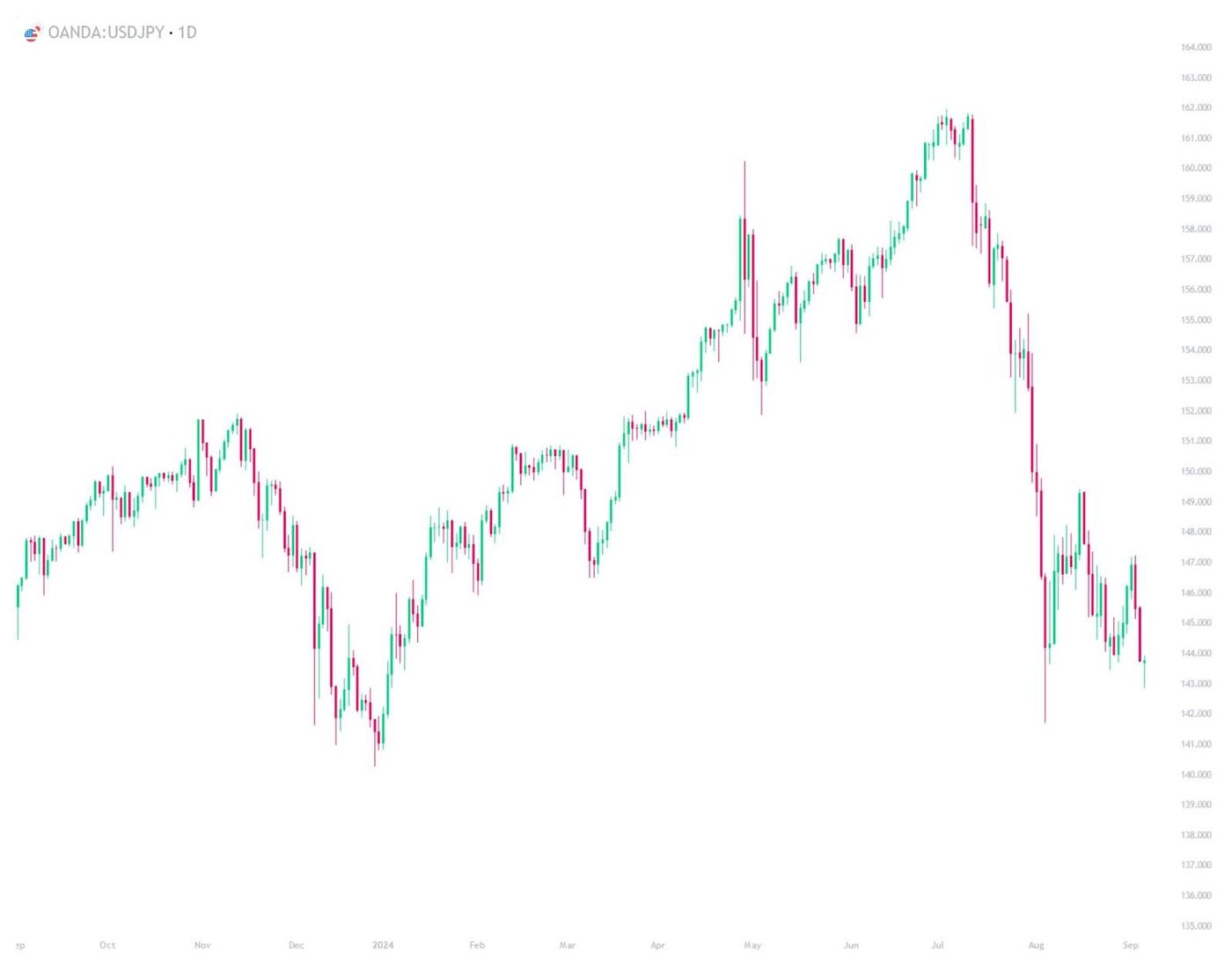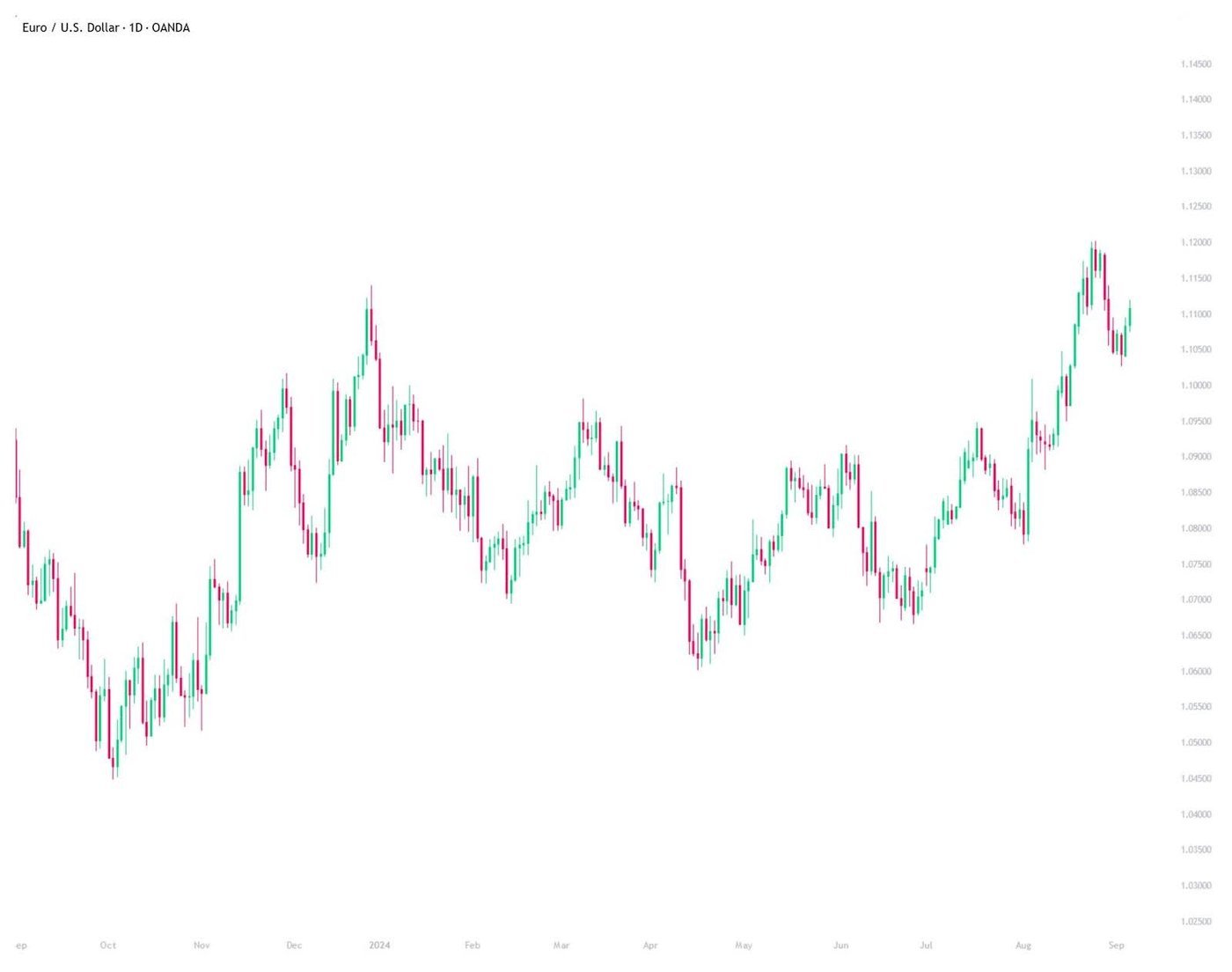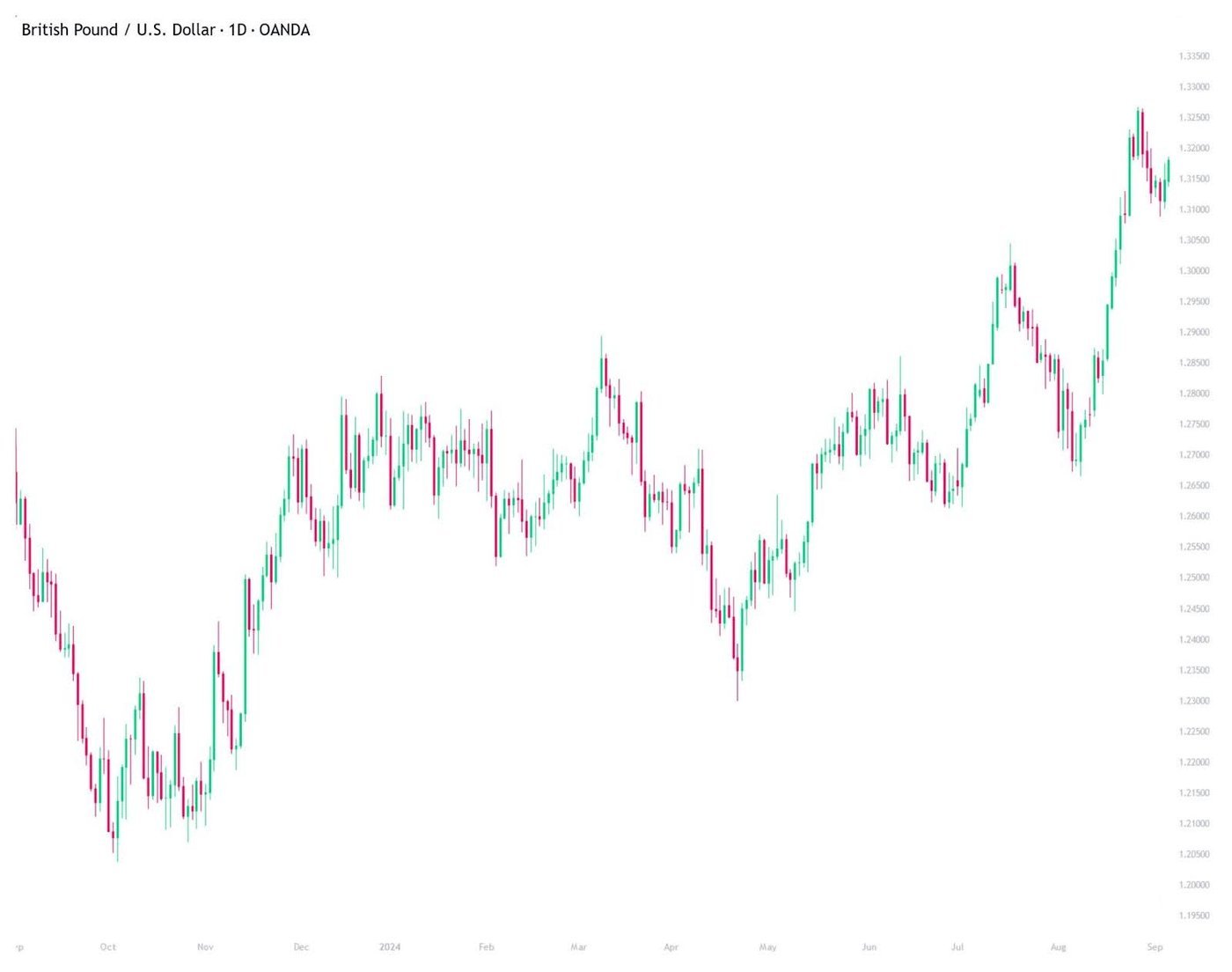With the game of interest rates in full swing amongst central banks, here are three currency pairs to watch ahead of the 2024 US presidential election.
USD/JPY, EUR/USD and GBP/USD: Three Pairs to Watch
In the current trading landscape, there is one economic keystone that seems to dominate over all else: interest rates.
As we look ahead to the US Election, here are some currency pairs you should be watching, as well as some key dates for your calendar.
USD/JPY: High Noon for the yen
With the Bank of Japan ending its landmark negative interest policy in March and raising rates for the first time in 17 years, 2024 was bound to be a significant year of change for the world’s third-most traded currency².
Compounded by a further rate hike in July, the Japanese yen remains statistically the most volatile major currency as traders continue to speculate how it fits into the global currency landscape under the watchful guise of new BoJ Governor Kazuo Ueda.
A chart showing the recent price action of the U.S dollar vs the Japanese yen. TradingView, 09/01/2023 - 09/05/2024. Past performance is not indicative of future results.
While this question has yet to be definitively answered, a trend of heightened yen volatility looks almost certain to continue between now and November’s election, as diverging stances between the Bank of Japan and Federal Reserve monetary policy remain at the forefront of traders’ minds.
USD/JPY: Technical overview
- Faced with considerable selling pressure since July, USD/JPY currently trades near 8-month lows and is within striking distance of erasing all gains made so far in 2024.
- In the next month of trading, attention is to be paid to the key level of 140.000, with a break to the downside inviting further selling pressure.
USD/JPY: Key events to watch
- US Nonfarm Payrolls (NFP)
In August, weak US jobs data sent an already shaky stock market into a free fall, with the S&P 500 dropping over 6% following the release¹. With this still fresh in traders’ minds, NFP will likely introduce volatile trading conditions once again as traders attempt to understand how jobs data will affect future monetary policy decisions made by the Federal Reserve.
In a similar fashion to August, the most recent NFP release reported worse-than-expected jobs data, causing both USD/JPY and the stock markets to fall yet again.
Now, less than 60 days out from the election, NFP remains one of, if not the most important, data points to follow.
At the time of writing, the next NFP releases are expected October 4th and November 1st respectively.
- US Federal Reserve and Bank of Japan Interest Rate Decisions
Both doing the rounds in the media and between traders alike, there is one burning question: ‘Will the Fed cut interest rates this month?’. With the rate of 5.5% being maintained since July of last year, how this current period of contractionary policy ends is a matter of when rather than if.
It could be argued that nowhere is the answer to this question more important than when considering the opportunity to trade USD/JPY, with both central banks becoming increasingly divergent in their stances on monetary policy:
Bank of Japan: Typically seen as dovish and is more likely to raise rates
Federal Reserve: Typically seen as hawkish and is more likely to cut rates
Historically, the Bank of Japan’s policy of lower, or even negative, base interest rates has all but ensured the yen would steadily decrease in strength versus the dollar, but now, and for the first time in 17 years, the winds of change are blowing.
Between now and the US Election, interest rate decisions are expected to be made on the following schedule:
Wednesday, September 18th: Federal Reserve Interest Rate Decision
Friday, September 20th: BoJ Interest Rate Decision
Tuesday, October 31st: BoJ Interest Rate Decision
EUR/USD: A Tale of Two Cities
As the world’s most traded currency pair², the relationship between that of the euro and U.S. dollar is one well-studied by traders.
A chart showing the recent price action of the euro vs the U.S dollar. TradingView, 09/01/2023 - 09/05/2024. Past performance is not indicative of future results.
In recent times, however, this relationship has undergone some significant changes.
No currency is excluded from the current game of interest rates in play by world central banks, and it would seem that some participants are more willing to show their hand than others, with the European Central Bank voting to cut rates from 4.50% to 4.25% in their June decision - decisively ahead of the Federal Reserve.
It remains to be seen whether the Federal Reserve will follow the ECB in its September decision, but with a higher current rate of interest offered on each dollar, foreign investment would be well-advised to pay close attention.
EUR/USD: Technical overview
- At the time of writing, the euro trades at a 10-month high versus the dollar and looks to break above monthly resistance levels around 1.10400.
- On the weekly chart, EUR/USD is encroaching on ‘overbought’ levels according to the Relative Strength Index (RSI), suggesting a pull-back might be needed before a move higher.
EUR/USD: Key events to watch
- US and EU Consumer Price Index
With inflation falling to 2.9%, August’s US CPI release reported the lowest level of inflation since April 2021. If this trend continues and inflation continues to fall, the case for a September rate cut by the Fed becomes stronger.
As traders attempt to speculate on the Fed’s next move, especially when seen as ‘behind’ the ECB, inflation data is one to watch.
Upcoming CPI Events:
Tuesday, October 1st: EU Core Harmonized Index of Consumer Prices
Thursday, October 10th: US Consumer Price Index
Thursday, October 1st: EU Core Harmonized Index of Consumer Prices
- European Central Bank and Federal Reserve Interest Rate Decisions
With recent comments by ECB President Christine Lagarde suggesting that further rate cuts are unlikely for now, the market has turned its gaze to the Federal Reserve and its upcoming rate decision on September 18th.
This being the last US rate decision before the Election, it will undoubtedly, at least partially, set the market tone surrounding the event.
GBP/USD: Curtain Calls
With this month marking two years since September 2022 and the pound's meltdown versus the dollar, GBP/USD trades over 25% higher only 732 days later, nothing short of a noteworthy performance.
As not only one of the United States's closest allies politically but also a major trading partner, the relationship between the dollar and the pound receives much attention, especially during times of political change.
Of course, political change has already reached the UK this year, but whether the US will follow suit is to be determined in two short months, with the age-old discussion of safe-haven vs. risk coming back to the fore.
A chart showing the recent price action of the British poun vs the U.S dollar. TradingView, 09/01/2023 - 09/05/2024. Past performance is not indicative of future results.
GBP/USD: Technical overview
- Currently trading around the key level of 1.30000, GBP/USD trades at its highest point since April 2022.
- Previous monthly price action would suggest that the next area of resistance is expected around 1.32500, with room to the upside if this level can tested and broken.
GBP/USD: Key events to watch
- US Federal Reserve and Bank of England Interest Rate Decisions
One month later than the ECB, the BoE chose to cut rates by 25 bps in their July decision, helping stoke the fire of the safe-haven vs risk debate:
British pound: Typically seen as a ‘riskier’ currency and is more likely bought and held in times of market optimism and high-risk appetite
United States dollar: Typically seen as a ‘safe-haven’ currency and is more likely bought and held in times of market pessimism and low-risk appetite
Recently, this dynamic has been further amplified, with the US currently offering a higher level of interest on each dollar than the pound, further solidifying differences in monetary policy.
With only one interest rate decision apiece between now and election day, the markets will be keenly watching for any potential for larger differences in interest rates.
Wednesday, September 18th: Federal Reserve Interest Rate Decision
Thursday September 19th: Bank of England Interest Rate Decision








